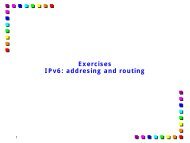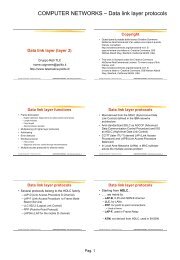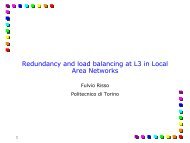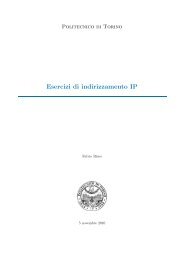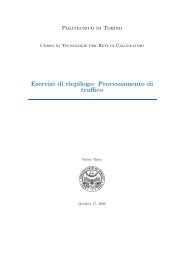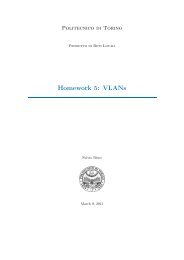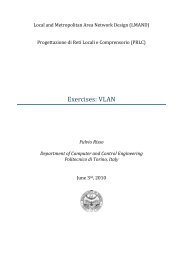High-Speed Policy-based Packet Forwarding Using Efficient Multi ...
High-Speed Policy-based Packet Forwarding Using Efficient Multi ...
High-Speed Policy-based Packet Forwarding Using Efficient Multi ...
Create successful ePaper yourself
Turn your PDF publications into a flip-book with our unique Google optimized e-Paper software.
3. If this interval has its complete bit map, bi, stored then<br />
retrieve this bit map. This require [n/w] memory accesses.<br />
Otherwise, first retrieve the bit map for the<br />
interval closest to i with a stored bit map. This bit<br />
map has at most [(l - 1)/2] bits different from the retrieved<br />
bit map. Fetch the, at most [(l- 1)/2] pointers<br />
corresponding to all intervals in between i and the interval<br />
whose bit map was received. This case requires<br />
~n/w] + [((1-1)/2)*(log n)/w] memory accesses. Construct<br />
the bit map for i using the pointers in sequence.<br />
4. Create a new bit map as the logical-AND of the retrieved<br />
bit maps for all Ic dimensions. Note that the<br />
AND operation can be done progressively as the bit<br />
maps are being constructed and does not necessarily<br />
require the entire bit map for each dimension to be<br />
completely retrieved.<br />
5. The index of the leading 1 in this bit map gives the<br />
applicable filter rule.<br />
4.3 Choice of 1<br />
One possible criteria for choice of I is to lower the memory<br />
requirement from O(n’). Setting 1 = 2n + 1 is an extreme<br />
case which reduces memory requirements to O(n log n) but<br />
requires retrieving n - 1 pointers. Let us present the tradeoff<br />
with an example. If we assume that bits of the bitmap are<br />
retrieved through pointers, as is the case when 1 = 2n + 1,<br />
then the total time for retrieving the bitmaps in each direction<br />
becomes r2n log nf w] which can be much higher than<br />
the [n/w] time required by the first algorithm. However, at<br />
the expense of higher execution time, the space requirement<br />
is reduced substantially.<br />
If on-chip memory is available however, complete bitmaps<br />
may be retrieved together with the pointers. The basic assumption<br />
behind the utilization of on-chip RAMS is that<br />
they be designed to be extremely wide. It is thus possible<br />
to increase the data bus width by at least a factor of 4 over<br />
an off-chip RAM. Current technologies, such as the ones offered<br />
by major ASIC vendors [25, 211, allow large portions<br />
of Synchronous Dynamic RAMS (SDRAMs) to be allocated<br />
in the same chip as logic. Note, that SDRAMs are ideal<br />
for retrieving bitmaps since they offer the best performance<br />
when accesses are sequential.<br />
So, let us assume that on-chip memory can be QI times as<br />
wide as off-chip memory. Let us assume that a full bitmap<br />
is kept in the on-chip memory for every 1 words. The total<br />
time required for retrieving this bitmap can be calculated<br />
as t = n/cyw. This time must be equal to the time required<br />
to retrieve at least l/2 pointers from the off-chip memory,<br />
or t = 1 log n/2w off-chip memory accesses. From the above<br />
two relations, we can easily calculate the optimal value of 1<br />
for a given technology as<br />
For example, if we assume (Y = 4 and n = 8K we get 1 = 315<br />
and we will need approximately 64 cycles to complete the<br />
operation. This will translate, using a 66MHz clock, to a<br />
processing rate of 1 million packets per second. Note, that,<br />
the total space requirement for the 8K filters is 32 Kbytes<br />
of on-chip memory and 32 Kbytes of off-chip memory for<br />
each dimension. This is definitely within the capabilities of<br />
current technology.<br />
5 Classification in Two Dimensions<br />
The 2-dimensional classification problem is of increasing importance<br />
in the evolving Internet architecture of the future.<br />
Drastically changing user expectations will necessitate the<br />
offering of different types of services and service guarantees<br />
by the network. Although RSVP, or similar reservation<br />
protocols, can offer end-to-end Quality-of-Service guarantees<br />
for specific flows, it is not clear whether such a reservation<br />
<strong>based</strong> model can be scaled for operation over highspeed<br />
backbones where a very large number of flows can be<br />
concurrently active. An alternative approach that has been<br />
proposed is route aggregated flows along specific traffic engineered<br />
paths. This directed routing is <strong>based</strong> not only on the<br />
destination address of packets, but on the source address as<br />
well [18]. RSVP or similar reservation protocols can be used<br />
for setting the aggregation and routing rules [18, 41. However,<br />
the key mechanism needed to support such a scheme in<br />
a high-speed core router is a 2-dimensional classification or<br />
lookup scheme that determines the next hop, and the associated<br />
resource allocations, for each packet as a function of<br />
both the source and destination addresses. In addition, multicast<br />
forwarding requires lookups <strong>based</strong> on both the source<br />
address and multicast groups [13, 261.<br />
The P-dimensional look-up problem is defined as follows:<br />
A query point p is a pair (s,d). For the forwarding problem,<br />
these values could correspond to source and destination<br />
addresses. For the multicast look-up application, the query<br />
point can correspond to the source address of a packet and<br />
to a group id that identifies the multicast group that the<br />
packet belongs to. A 2-dimensional look-up table consists<br />
of pairs (si,&) where each sI is a prefix of possible source<br />
addresses and each di is a contiguous range or point, of possible<br />
group identifiers or destination addresses. Each pair<br />
defines a rectangle in 2-dimensions. Note that rectangles<br />
can have arbitrary overlaps. Given a query point p, the<br />
search or look-up problem is to find an enclosing rectangle<br />
(if any), say rj = (sj, dj), such that p = (s, d) is contained in<br />
r3, and such that sj is the most specific (longest) matching<br />
prefix of s. The dj can be ranges including prefix ranges.<br />
The matching dj, when multiple matches occur for a specific<br />
sj due to overlaps in the d direction, is taken to be the<br />
one of highest priority. Note that the d dimension allows<br />
any contiguous range and is not restricted to prefix ranges<br />
only. Therefore, if the d direction corresponds to destination<br />
addresses, then ranges in the destination addresses do<br />
not have to be in powers of 2 (which would be the case with<br />
prefix ranges). This might be particularly useful if destination<br />
addresses are concatenated with layer-4 destination<br />
ports or some other similar header field (to form a”2 l/2<br />
dimensional” lookup).<br />
We are interested in solutions for use in IP routers. This<br />
means that the look-up tables may have as many as 216<br />
entries and perhaps more. Also, we are interested in only<br />
worst-case performance of the algorithms since we want to<br />
avoid queueing for header processing in order to provide QoS<br />
guarantees.<br />
Let n denote the number of entries in the multicast forwarding<br />
table. A simple solution that takes only O(logn)<br />
time and O(n’) space is to have an n x n array with each entry<br />
representing the highest priority rectangle that encloses<br />
the point corresponding to the coordinates represented by<br />
the entry. The look-up is done with two binary searches.<br />
However, this is clearly impractical in space when the number<br />
of filtering rules is n = 216. The O(n2) space is because<br />
the same rectangle can be represented in O(n) locations.<br />
210



